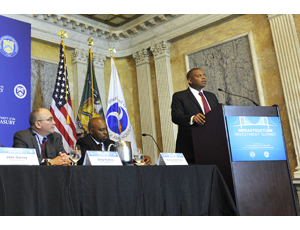
The Obama administration is pushing ahead with its campaign to draw more private dollars to narrow the huge U.S. infrastructure-finance gap, announcing on Sept. 9 a flurry of project-funding actions.
Officials made the announcements at a Washington, D.C., “summit,” at which Cabinet secretaries heard ideas from public and private officials on further ways to spark increased private investment in highways, bridges and other infrastructure.
Transportation Secretary Anthony Foxx told attendees at the meeting that his department had approved a $950-million Transportation Infrastructure Finance and Innovation Act loan for the Interstate 4 project in Orlando, Fla. The loan is the largest to a public-private-partnership project in the TIFIA program’s 16-year-history.
Foxx also said DOT had approved a $1.2-billion allocation of federal private-activity bonds to the Pennsylvania Dept. of Transportation for its ambitious program to replace 600 bridges in 42 months, using a single public-private partnership (P3).
Moreover, he said DOT is providing $20 million for a new transit-oriented-development pilot program.
Other agencies are taking infrastructure-related action, too. Treasury Secretary Jacob Lew said his department will commission an independent report to identify planned transportation and water infrastructure projects that are judged to have the greatest economic impact.
The White House said that the Agriculture Dept. had approved $518 million in loans for rural electricity projects.
In the nongovernment sector, the California State Teachers’ Retirement System is forming a consortium with other pension funds to invest in U.S. infrastructure, Christopher Ailman, chief investment officer, said at the summit, which was held at Treasury’s headquarters.
The White House also said the Ford and Rockefeller foundations are teaming up on a new effort to stimulate innovation in infrastructure projects.
As part of President Obama’s “Build America Investment Initiative,” announced on July 17, he directed Lew and Foxx to lead an interagency infrastructure-finance working group to identify ways to overcome hurdles to private financing and to speed projects to completion.
They are to produce recommendations by Nov. 14. The summit, part of the two secretaries' search for suggestions, drew more than 100 top infrastructure-finance officials from the public and private sectors.
Much of the discussion at the public portion of the meeting centered on the transportation sector, which has had more P3 and related types of private participation than other markets.
Infrastructure's financial needs are immense. Lew said the U.S. faces a $1-trillion infrastructure-funding gap by 2020, counting all major sectors.
Commerce Secretary Penny Pritzker, who also addressed the gathering, said the stock of all public infrastructure was valued at nearly $10.8 trillion in 2012, according to Commerce’s Bureau of Economic Analysis. It will take $360 billion per year just to maintain that infrastructure’s current condition, she added.
Lew said that “while direct federal spending on infrastructure is indispensible, we recognize the reality that budget limitations at every level of government make it all the more important to come up with fresh, innovative ways to unlock capital and get more projects under way.”


Post a comment to this article
Report Abusive Comment